Creating the Perfect Home Office: A Guide to Optimal Productivity and Style
As remote work continues to grow in popularity, the importance of a well-designed home office cannot be overstated. A thoughtfully curated workspace can significantly enhance productivity, focus, and overall well-being. In this blog post, we will explore key elements to consider when creating the perfect home office that balances functionality, comfort, and style.
1. Selecting the Ideal Space
Choose a dedicated area in your home that can be transformed into a productive work environment. A spare room, an unused corner, or even a well-designed alcove can be the perfect starting point. Ensure the space offers ample natural light, minimal distractions, and sufficient privacy to create a focused atmosphere.
2. Ergonomics and Comfort
Investing in ergonomically designed furniture is crucial for long hours of work. Consider a comfortable chair with adjustable height and lumbar support to maintain good posture. Opt for a desk that provides ample surface area and accommodates your work essentials. Remember to position your monitor at eye level to reduce strain on your neck and eyes.
3. Lighting
Proper lighting is vital for productivity and reducing eye strain. Maximize natural light by positioning your desk near a window. Additionally, incorporate task lighting with adjustable desk lamps or overhead lighting to supplement natural light during darker hours. Experiment with warm or cool LED bulbs to find the lighting that suits your work style.
4. Declutter and Organize
A cluttered workspace can hinder concentration and creativity. Keep your home office tidy by incorporating smart storage solutions. Invest in shelves, drawers, and file organizers to declutter your desk and store essential documents. Use decorative baskets or boxes to neatly stow away cables, chargers, and other office supplies.
5. Inspiring Decor
Personalize your home office with decor that inspires and motivates you. Choose a color scheme that promotes focus and creativity, such as soothing blues or energizing greens. Hang artwork, motivational quotes, or vision boards that resonate with your professional goals. Incorporate indoor plants to add a touch of nature and enhance air quality.
6. Technology and Connectivity
Ensure seamless connectivity and productivity by optimizing your tech setup. Invest in a reliable high-speed internet connection and a robust router. Arrange cables neatly and use cable management solutions to avoid a cluttered look. Consider investing in a second monitor or docking station to enhance multitasking capabilities.
7. Acoustic Considerations
Creating a quiet environment is essential for concentration. Incorporate noise-absorbing elements like acoustic panels, thick curtains, or rugs to reduce echoes and outside disturbances. Alternatively, consider using white noise machines or instrumental music to create a soothing ambiance.
8. Green and Sustainable Elements
Incorporate sustainable elements into your home office to promote a healthier environment. Choose furniture made from eco-friendly materials like bamboo or recycled wood. Opt for energy-efficient lighting fixtures and invest in a programmable thermostat to conserve energy. Utilize natural ventilation whenever possible to reduce the need for air conditioning.
Designing the perfect home office is a blend of aesthetics, functionality, and personalization. By considering factors such as ergonomics, lighting, organization, decor, technology, acoustics, and sustainability, you can create a workspace that promotes productivity, creativity, and overall well-being. Embrace your unique style while maintaining a clutter-free and inspiring environment. Remember, a well-designed home office is an investment in your professional success and work-life balance.

